This post may contain affiliate links. Please read our disclosure policy.
When it comes to homemade pickles, few varieties can match the tangy flavor and crisp texture of refrigerator dill pickles. With just a handful of ingredients and a simple brining process, these pickles are not only easy to make, but they also offer a burst of freshness and flavor that you won’t find in store-bought alternatives.
Even if this is the first time you try to make your own homemade jar of pickles, you’ll see how easy this recipe is! What’s not to love about a homemade crunchy dill pickle when you’re eating a loaded club sandwich, a homemade sloppy joe sandwich, or a stuffed burger?
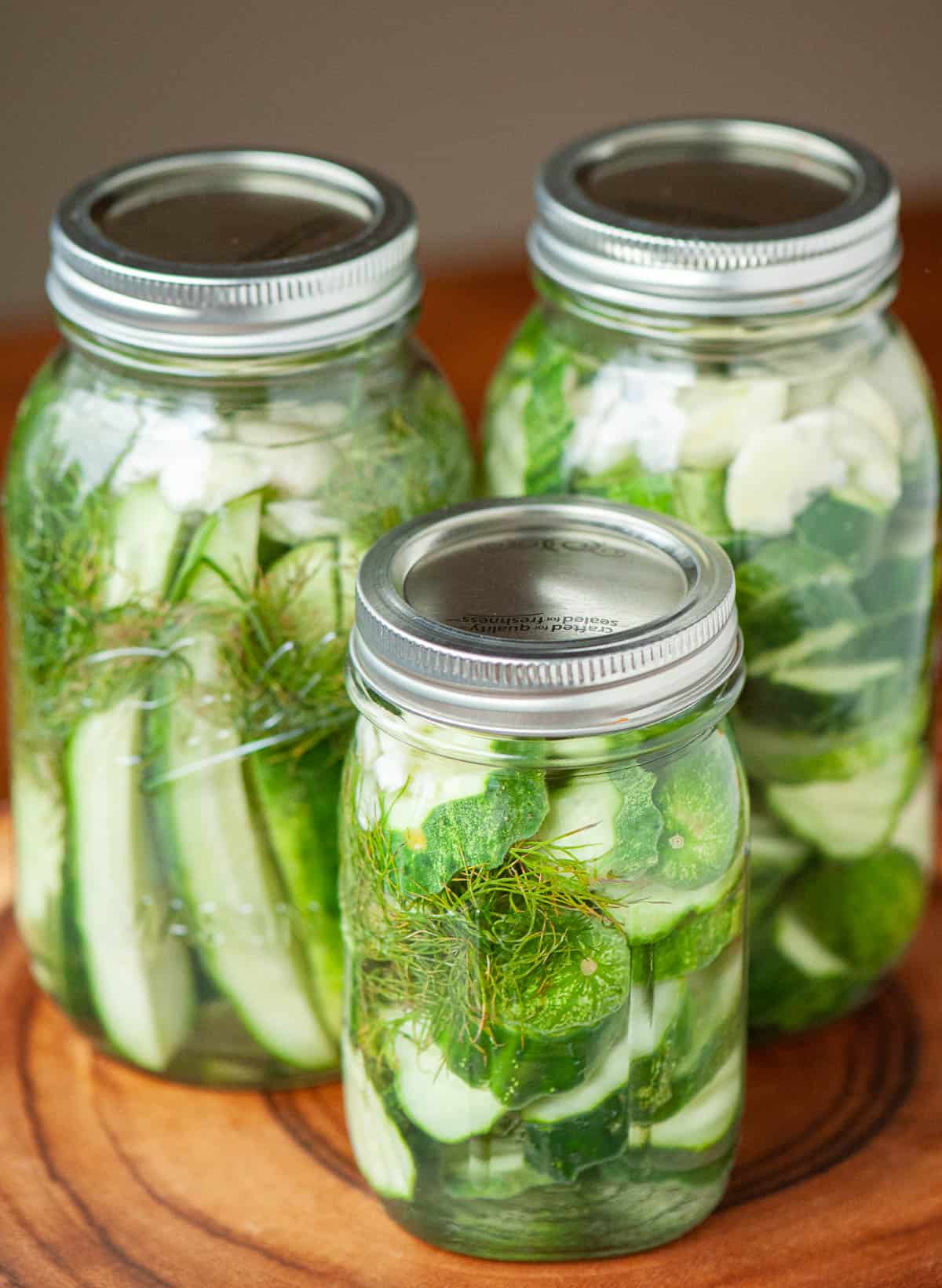
Table of Contents
- Why I Make These Pickles Every Summer
- Ingredients Needed for this Dill Pickle Recipe
- How to Make Refrigerator Dill Pickles
- Step 1: Thoroughly Wash the Cucumbers
- Step 2: Slice the cucumbers into slices or spears.
- Step 3: Prepare the Garlic and Dill
- Step 4: Make the Pickle Brine
- Step 5: Add Ingredients to Jars
- Step 6: Pickle the Cucumbers
- Pickling Cucumbers vs Other Cucumber Varieties
- Homemade Pickle FAQs
- My Favorite Dill Pickle Recipes
- Easy Refrigerator Dill Pickles Recipe
Why I Make These Pickles Every Summer
Every summer, this easy homemade pickle recipe is one of my most viewed recipes, and for good reason!
- Quick and Easy Process – One of the best things about refrigerator dill pickles is their simplicity and convenience. Unlike traditional canning methods that involve a hot water bath, refrigerator pickles require no canning process. Instead, you can store them in quart or pint jars directly in the refrigerator. Other recipes that use a similar method are my Quick Pickled Radishes and my Pickled Beets.
- Crisp and Flavorful – The absence of heat processing allows the pickles to retain their crunchiness, resulting in a crisp pickle that is ready to enjoy the next day.
- Versatile and Delicious – Fresh pickles make a great snack. The pickle juice can be used in recipes like remoulade sauce. They can also be used in recipes like potato salad or ham salad, relishes, or even on a charcuterie board.
These are seriously the best dill quick pickles you’ll ever enjoy!
Ingredients Needed for this Dill Pickle Recipe
- Fresh Dill and Garlic Cloves – These aromatic components infuse the pickling brine with their distinct flavors. The dill’s herbal notes add depth, while the garlic provides a subtle pungency that complements the tangy vinegar brine perfectly.
- For the Vinegar Brine – White vinegar plays a crucial role in the pickle-making process. The vinegar brine not only acts as a preservative but also imparts that signature tangy flavor. The combination of vinegar, water, kosher salt, and a bit of sugar create a flavorful brine that balances the freshness of the cucumbers.
How to Make Refrigerator Dill Pickles
The process couldn’t be easier. Here’s an overview on how to make them, but always refer to the recipe card below for full instructions.
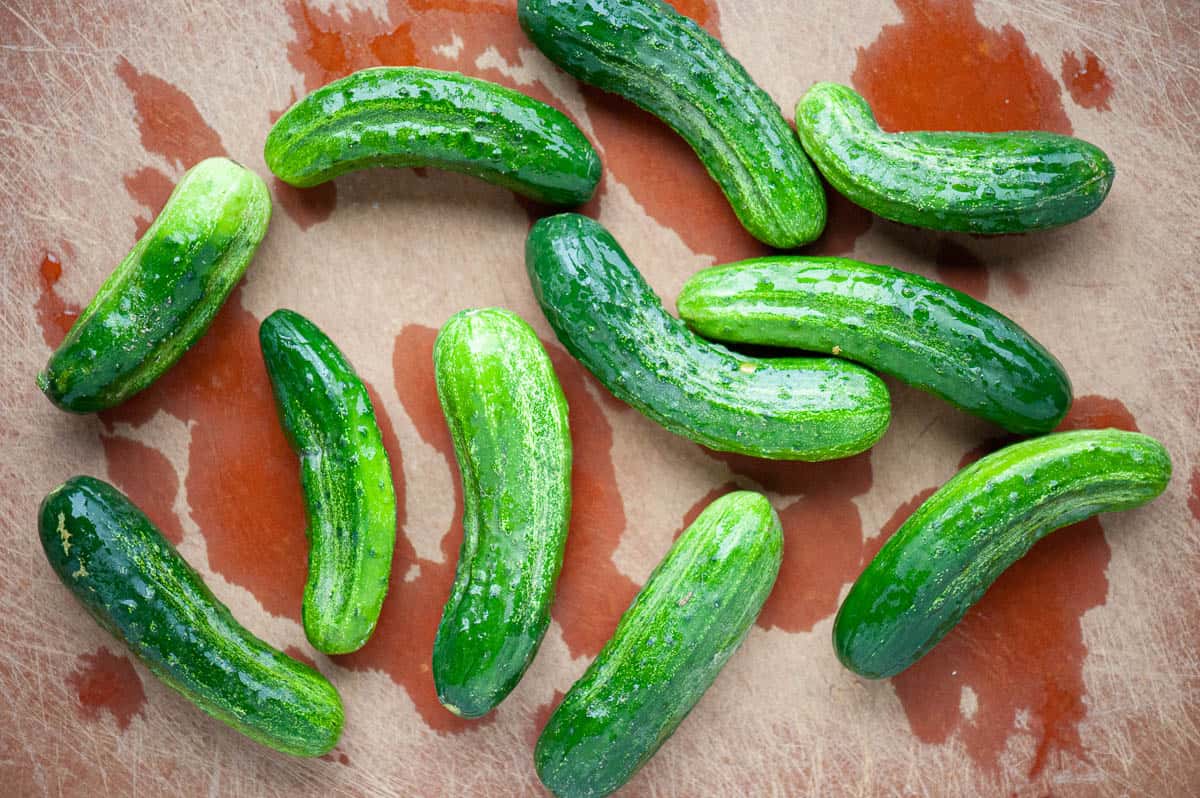
Step 1: Thoroughly Wash the Cucumbers
You want to make sure they’re completely free of any dirt or residue.
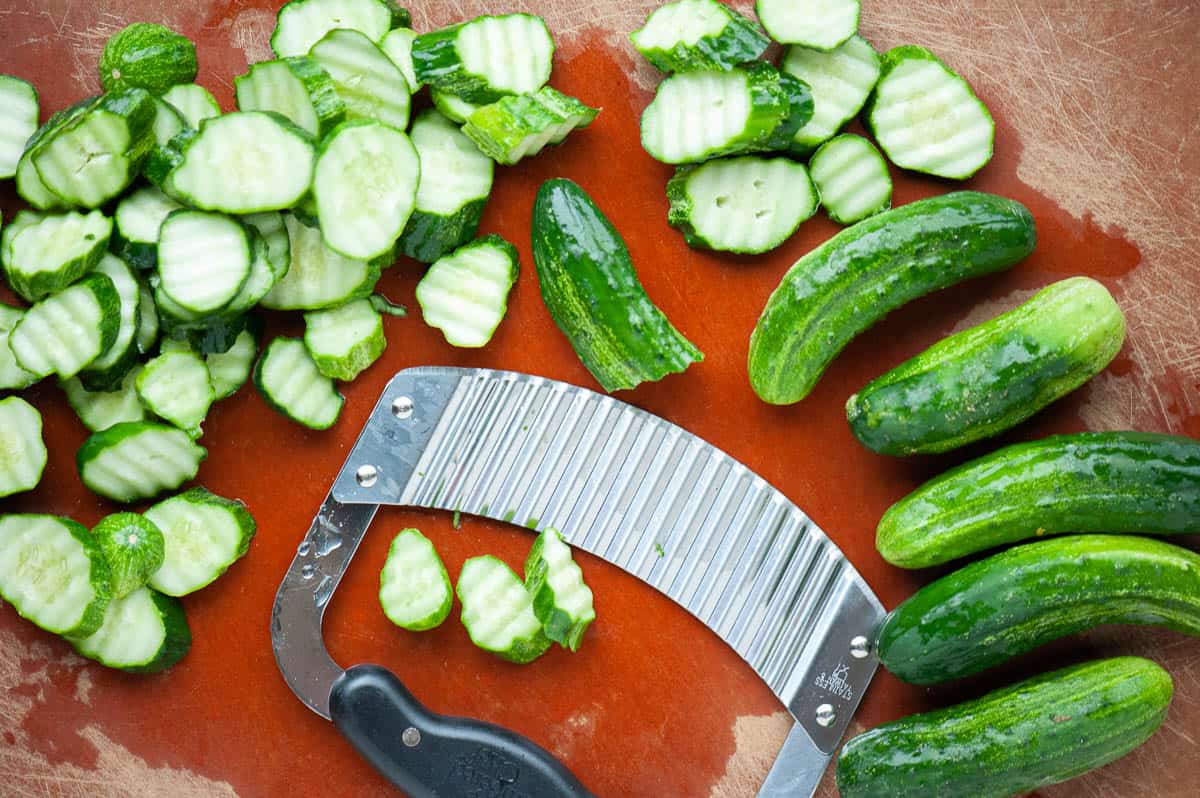
Step 2: Slice the cucumbers into slices or spears.
No need to discard the ends of the cucumbers – they make great tangy dill pickles too! To get the fun wavy cut, use a crinkle cutting tool.
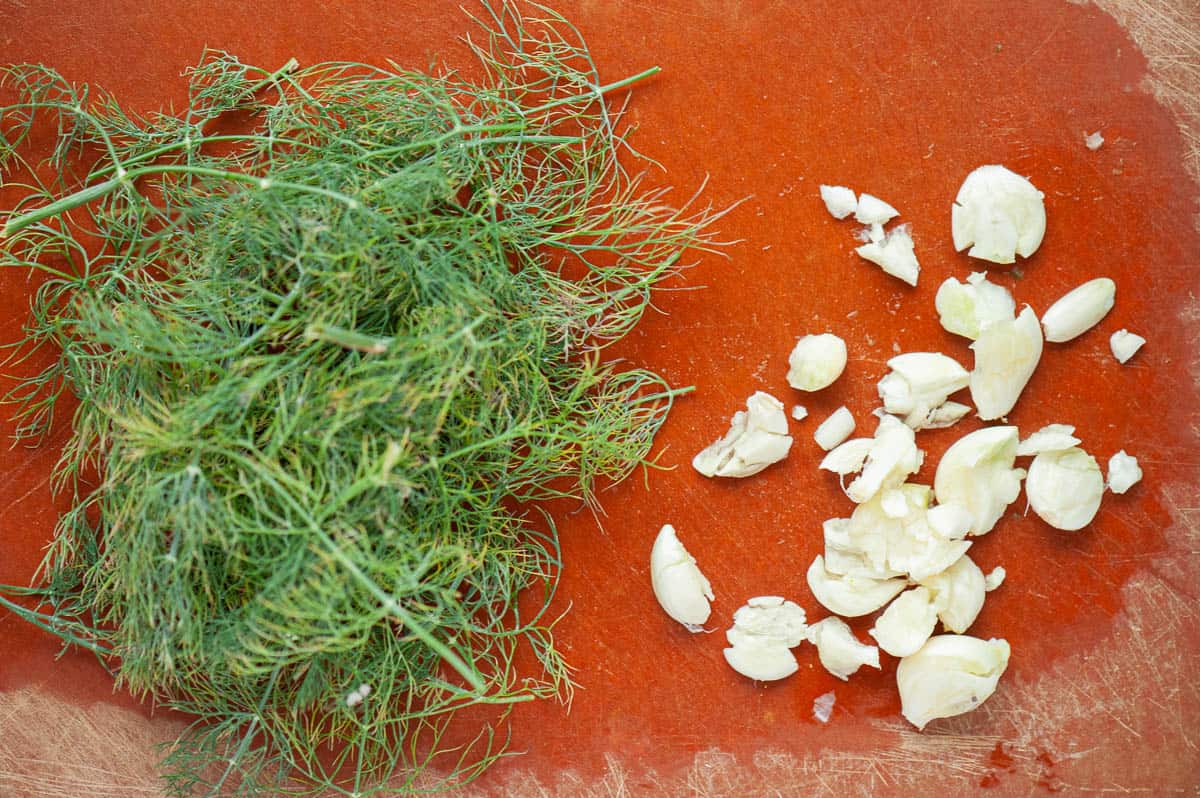
Step 3: Prepare the Garlic and Dill
Remove the garlic cloves from the bulb. Smash them by holding a large chef’s knife or the bottom of a glass on top of them and pressing down.
Separate the fresh dill from the thick stems.
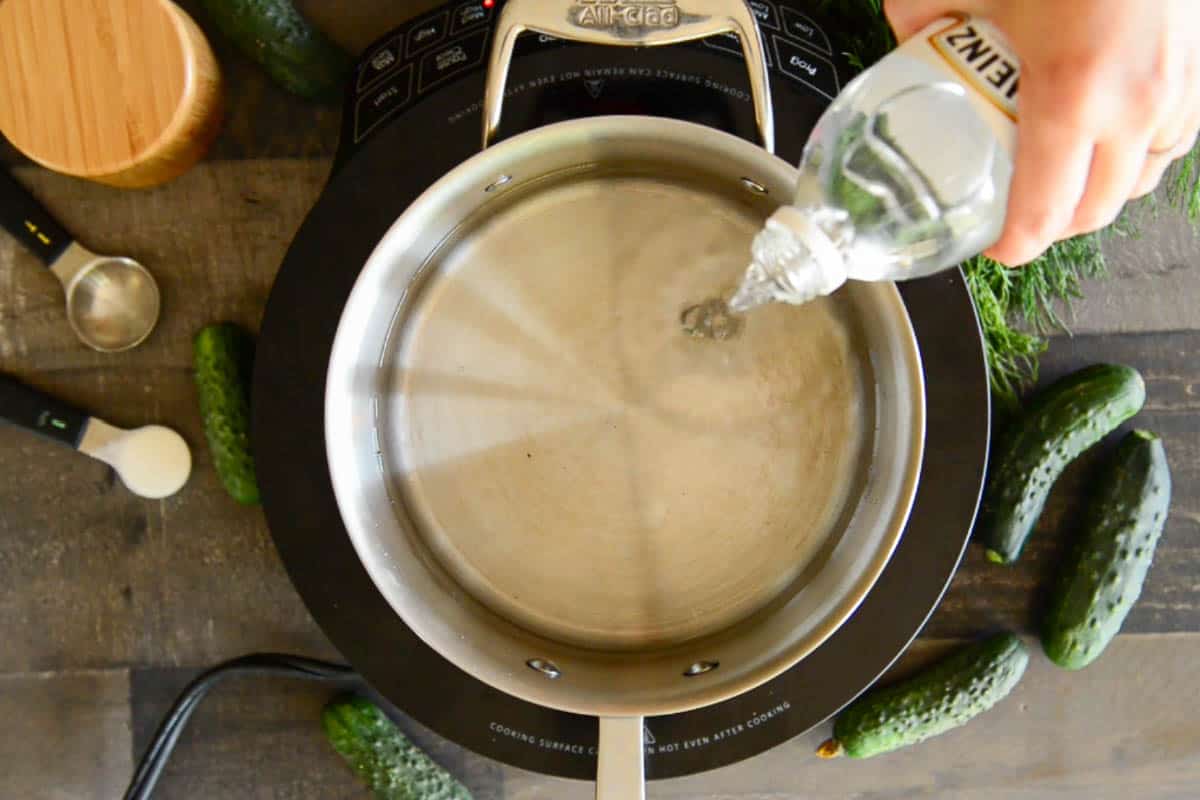
Step 4: Make the Pickle Brine
Heat the brine in a saucepan. The brine consists of water, vinegar, salt, and sugar.
Bring this mixture to a rolling boil and then remove it from the heat. You basically want to swirl it around so that the salt and sugar dissolve. Let the brine cool to room temperature.
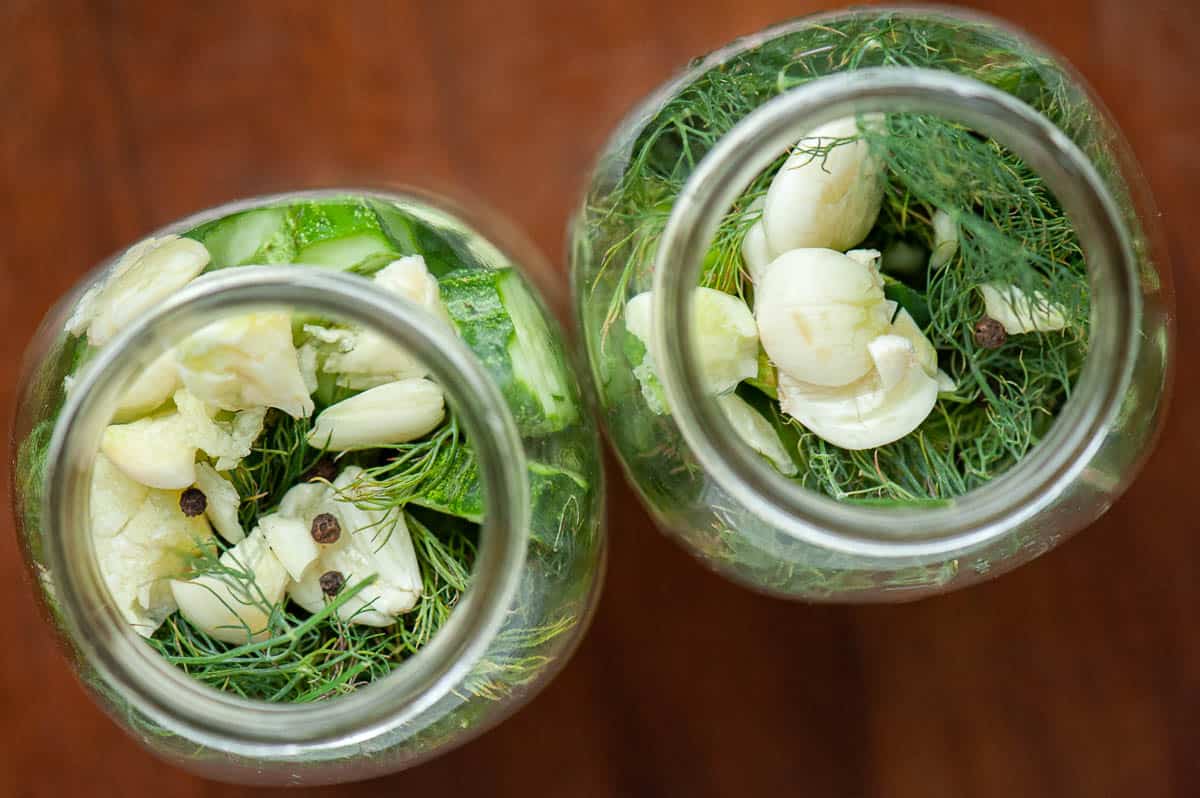
Step 5: Add Ingredients to Jars
Loosely layer the prepared cucumbers with the smashed garlic, fresh dill, and black peppercorns into sanitized Mason quart jars (aka canning jars). You can use pint-sized or half-gallon sized jars if you wish too.
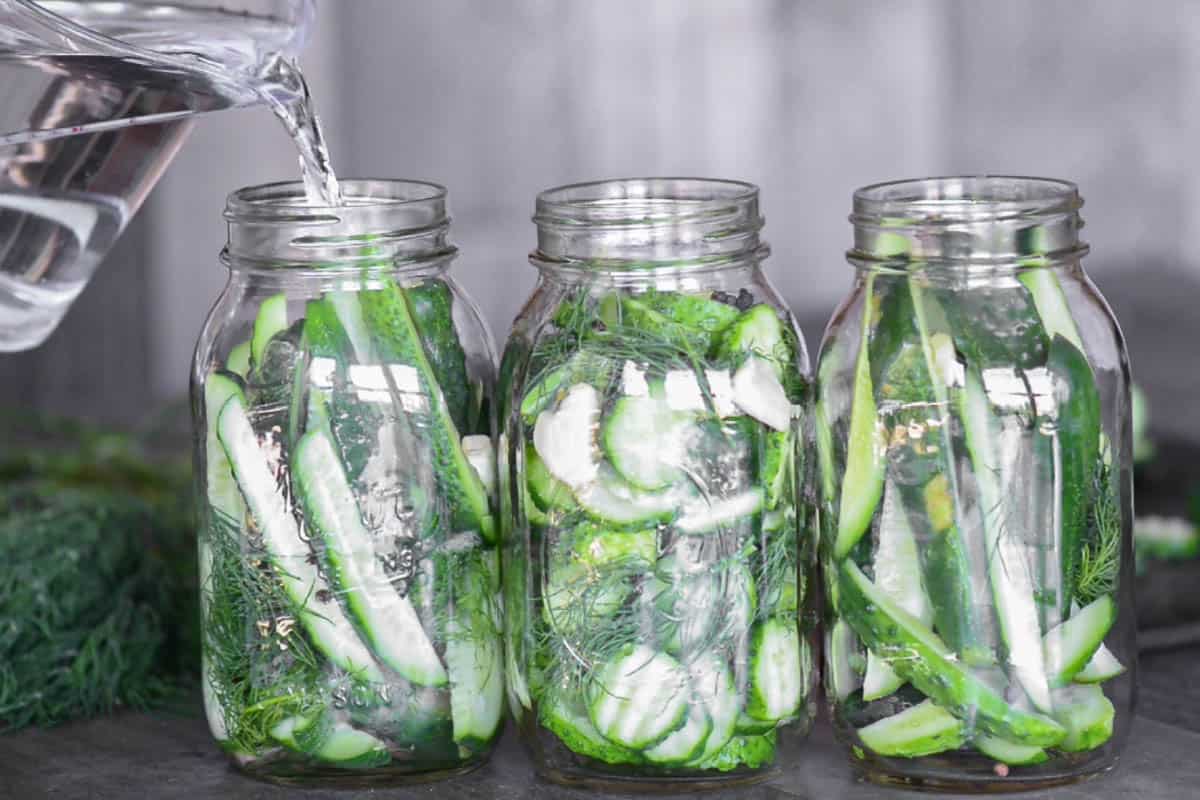
Step 6: Pickle the Cucumbers
Pour the brine over your freshly cut cucumbers that have been arranged in the jars with the garlic, dill, and peppercorns.
Place the homemade dill pickles in the refrigerator for a week and voila – they’re ready!
Pickling Cucumbers vs Other Cucumber Varieties
Pickling cucumbers, also known as picklers or Kirby cucumbers, are cucumbers specifically cultivated for the purpose of pickling.
They are distinct from other types of cucumbers, such as slicing cucumbers or salad cucumbers, due to their unique characteristics. Here are some ways in which pickling cucumbers differ from other cucumbers:
- Size: Pickling cucumbers are usually smaller in size compared to slicing cucumbers. They are typically shorter, measuring around 3 to 4 inches (7.6 to 10.2 cm) in length, which makes them more suitable for fitting into jars and brining solutions.
- Texture: Pickling cucumbers have a crisp and firm texture, which helps them retain their crunchiness during the pickling process. This is an important quality for producing delicious pickles.
- Skin: The skin of pickling cucumbers is thinner and often more bumpy or warty compared to slicing cucumbers. This allows the pickling solution and spices to penetrate the cucumber more easily, resulting in a well-flavored pickle.
- Seeds: Pickling cucumbers tend to have smaller seeds and a lower seed count compared to slicing cucumbers. This is desirable because larger seeds can sometimes contribute to a softer texture in pickles.
- Taste: Pickling cucumbers generally have a milder and less watery flavor compared to slicing cucumbers. Their flavor profile is better suited to absorbing the flavors of the brine and spices used in the pickling process.
Due to these characteristics, pickling cucumbers are the preferred choice when making pickles.
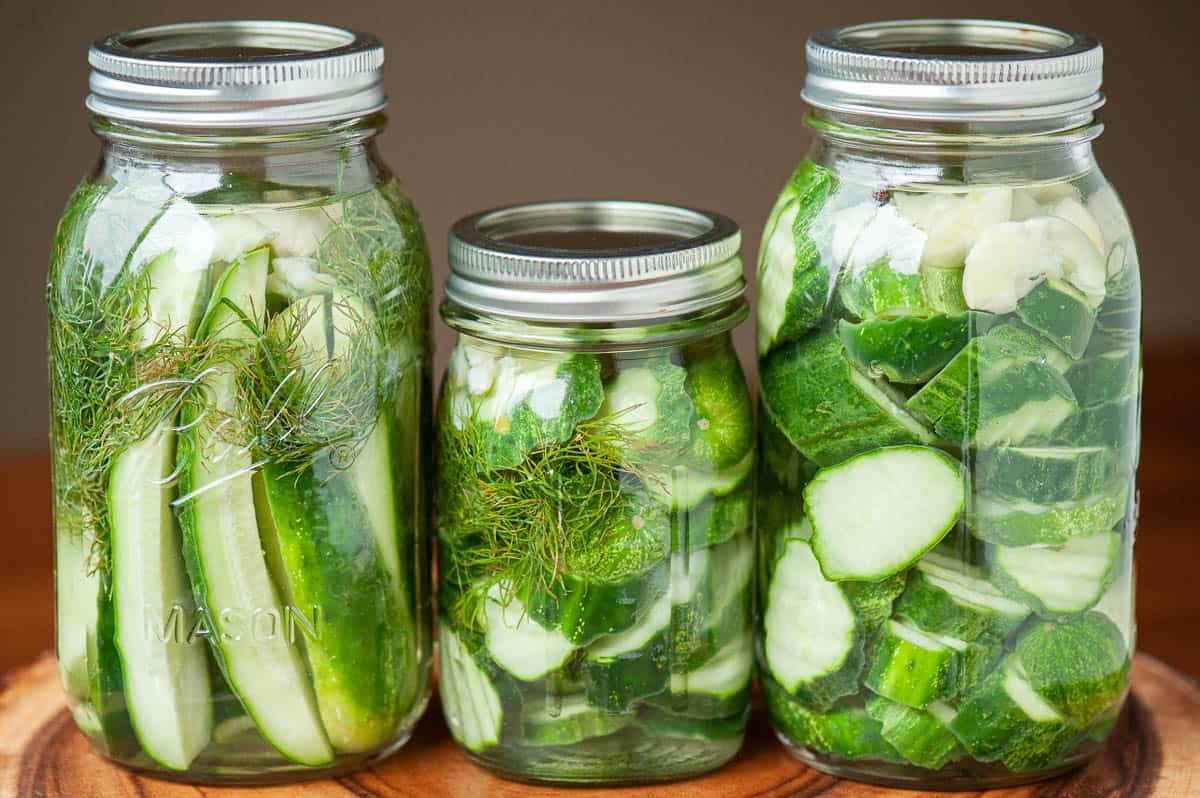
Homemade Pickle FAQs
Because of the popularity of this recipe, I get a lot of questions and comments. Here are the most common questions I get with this recipe along with my answers.
I’ve always found pickling cucumbers at the farmer’s market. They seem to be everyone’s favorite to grow in their own garden as well. One pickling cucumber plant will produce a ton!
Grocery stores will carry pickling cumbers as well, but they are definitely a seasonal item.
Yes, in fact, many quick-pickle recipes call for ACV. With dill pickles, however, I prefer the taste of white vinegar, but this is just what I like.
The salt and vinegar brine will keep these cucumbers fresh in the refrigerator for a long time. That said, I think they are best if eaten within a couple of months.
I find that the fresh cucumbers, fresh dill, whole peppercorns, and fresh garlic along with the brine are all that you need and people really do love them!
You can certainly add additional pickling spices but they aren’t necessary to still get great taste and texture.
Yes! I’ve had readers tell me they added fresh green beans, carrots, cauliflower, asparagus, etc. and they all worked out amazingly well.
I get asked this a lot. Pickling cucumbers are ideal because they are small and firm so they give that great pickle crunch.
You can pickle any kind of cucumber, but because of the moisture content in slicing (aka English) cucumbers, they will be more mushy but they will still taste great.
The closest substitute to traditional pickling cucumbers are Persian cucumbers and those are often carried at major grocery stores year round.
Yes! That’s why I recommend always using a clean utensil to get the pickles out. You don’t want to introduce any bacteria from dirty fingers. Use the brine over and over again.
Yes, you can use whole. They just might take a longer time to absorb all of the flavors from the brine. Slicing them just makes the pickling process go faster.
My Favorite Dill Pickle Recipes
If you love dill pickles, you’ll want to try these:
If you tried this Dill Pickle recipe or any other recipe on my website, please leave a 🌟 star rating and let me know how it went in the 📝 comments below. Thanks for visiting!
Pin this now to save it for later
Pin ItEasy Refrigerator Dill Pickles
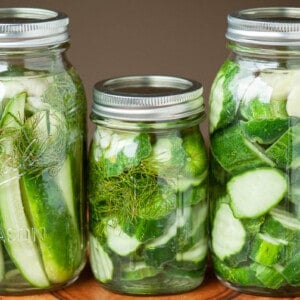
Ingredients
- 12 pickling cucumbers quantity can vary depending on size
- 4 cups water
- 2 cups white vinegar
- 2 tablespoons kosher salt
- 1 teaspoon sugar
- 1 bunch fresh dill amount can vary depending on preference, thick stems removed
- 1 head garlic skins removed, cloves smashed (use fewer cloves if its a strong garlic)
- 1 tablespoon peppercorn kernels I usually use about 10 peppercorns per jar, give or take
Instructions
- Prepare ingredients: Thoroughly wash 12 pickling cucumbers. Slice cucumbers into 1/4-inch thick slices or spears. Set aside. Smash garlic cloves and separate dill from thick stems. Also, sanitize mason jars by running them through the dishwasher.
- Prepare brine: To make the brine, combine 4 cups water, 2 cups white vinegar, 2 tablespoons kosher salt, and 1 teaspoon sugar in a medium saucepan. Bring the mixture to a boil and swirl the pan to ensure the sugar and salt dissolve. Remove the pan from heat and cool to room temperature.
- Make the pickles: Layer the prepared cucumbers with 1 bunch fresh dill, smashed 1 head garlic, and 1 tablespoon peppercorn kernels in the jars. Do not pack them super tight as you you'll want room for the brine. Finish by adding enough brine to cover the cucumbers. Seal with an airtight lid and store in the refrigerator. The flavor is best if stored for at least one week, but they can be eaten at any time. Pickles should be good for at least 4-6 weeks after that.
- This recipe made enough for me to fill one pint and fill two quart jars.
Notes
- Quantities listed make about 3 quart-sized jars
- The amount of dill and garlic can vary depending on taste. I prefer to pack my jars with a ton of fresh dill which is why I don’t specify a specific quantity, but you can add as little or as much as you prefer.
- The intensity of the garlic will impact the intensity of the pickles. If your garlic is particularly strong, use less if you are sensitive to the taste.
Video
Nutrition
Nutrition information is automatically calculated, so should only be used as an approximation.
This post was originally created in 2015 and has been updated with updated photos and more helpful information, but this reader-favorite recipe has always remained the same.
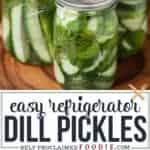
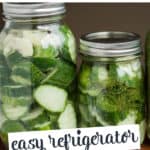
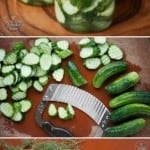


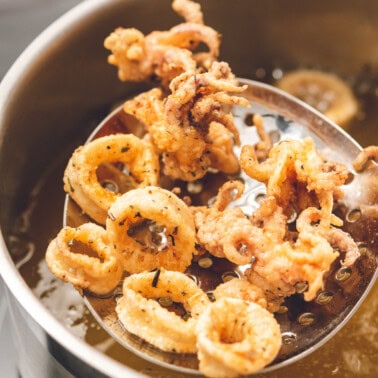
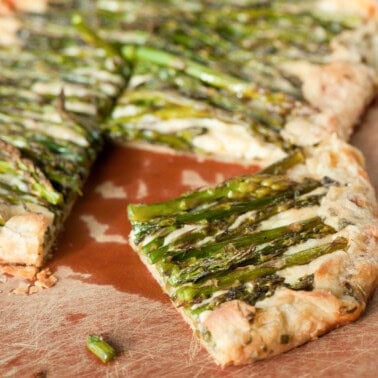
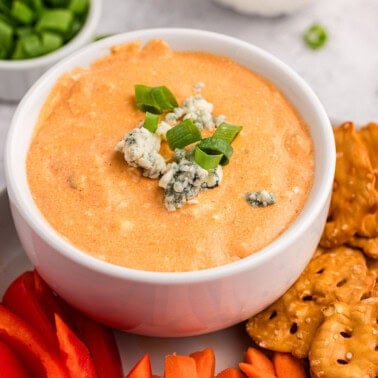









Made a batch last night, sounded amazing, and I hope it’s as good when the pickles are ready to eat
I want to try this recipe but right now I only have 4 cucumbers right now. If I make the full recipe of brine can I store the extra brine until I have more cukes ready?
Yes – and I’m sorry for such a late reply. Summer has been BUSY!
I’ll try your recipe. My wife has tried different recipes and the pickle gets soft.
As long as your refrigerate and don’t can in a hot water bath, they should remain crisp.
These are SO GOOD. I made them a week ago and waited until today to taste them. I made them exactly as written and they’re perfect in every way-crunchy with the perfect balance of vinegar, sugar, salt, and dill. Thank you for a fantastic recipe!
Ty ty ty planted a garden for the first time in our new house and I have cucumbers coming out my ears this recipe is helpful ty again and delicious yummy
can the jars be opened to add more spice after 24 hours or will it disrupt the brine process
Sure can! They’re not sealed, so open away.
This is my first try on refrigerator pickles and they turned out delicious! Such a great crunch and a great flavor. I always have such a difficult time gauging the amount of cucumber to brine to jar ratio. I did this recipe twice. Once with 1/2 pint reclosable jars and needed to make more brine. 2nd time I used pint jars and was true to recipe proportions.
Where is the recipe?
The full recipe card is at the bottom of the post. You can scroll down or you can click the “jump to recipe” button that is at the top of every post.
Perfect!
I grow my own pickling cucumbers and dill in my garden, and make these every year. Everyone asks me if I’m going to make them again, then raves about them.